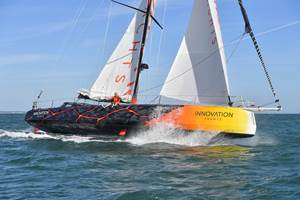Benteler SGL to supply composite leaf springs for new Volvo XC90
The rear axle of the new Volvo XC90 crossover SUV will use a composite leaf spring molded by Austria-based Benteler SGL using Henkel's Loctite MAX 2 polyurethane resin in RTM.
Henkel (Düsseldorf, Germany) reported on Dec. 11 that a fiber-reinforced composite leaf spring based on its polyurethane matrix resin Loctite MAX 2 is being used in the chassis of the new Volvo XC90, a crossover SUV of which the rear axle concept is to serve as a platform for other model series. Benteler SGL Composite Technology GmbH (Ried im Innkreis, Austria), a manufacturer of composite components for automotive applications, expects to produce several hundred thousand of these leaf springs per year.
In its alliance with Benteler SGL, aligned to the development and large-scale production of a composite leaf spring for Volvo Cars, Henkel has contributed in particular its process know-how in relation to RTM (resin transfer molding) so as to further optimize the cycle times that occur in the manufacture of fiber-reinforced components. Because of its low viscosity, the polyurethane matrix resin Loctite MAX 2 from Henkel rapidly fills the mold and quickly impregnates the fiber, resulting in short injection times. With the curing rate also substantially faster than that of epoxy resins, cycle times are shorter overall. Loctite MAX 2 has been successfully used in the mass production of leaf springs since 2013. In addition, the current project uses selected additives that make the curing process faster and more flexible.
“Within the development network comprising ourselves, BENTELER-SGL and Volvo Cars, the component manufactured with our polyurethane resin was subjected to extensive automotive-specific testing and validation,” says Frank Kerstan, global program manager automotive composites, Henkel Adhesive Technologies. “Applying our expertise in process optimization, we were able to demonstrate that this polyurethane technology could satisfy all the criteria of long service under environmental influences such as temperature and humidity.”
The leaf springs on new Volvo XC90 offer a highly compact design as well as weight savings of 4.5 kg compared to a conventional coil-spring concept. Further functional benefits arise from a smoother ride and improved NVH (noise, vibration, harshness) behavior. The trunk volume is also increased because there are no suspension turrets. Volvo operates on the basis of what is called Scalable Platform Architecture (SPA), according to which certain successfully implemented concepts are flexibly adapted for application to further vehicle models. The new rear axle is likewise destined to be incorporated into additional automobile models in the years to come, leading to several hundred thousand vehicles being fitted with it every year. The new Volvo XC90 is, therefore, just the beginning.
“The demands made in the automobile industry on the cost efficiency and reliability of production processes are huge,” says Frank Fetscher, head of business development at Benteler-SGL Automotive Composites. “The example of our leaf spring for Volvo Cars demonstrates that fiber composite mass production is today already a reality. What’s more, with this flexible component design, we are able to cover an entire platform with a relatively small number of spring variants. Having the right partner in Henkel, we have been able to build on our expertise, enabling us to further optimize the level of automation applied in our composite manufacturing operation. This current project shows that our lightweight leaf spring concept is suitable not just for commercial vehicles but also for passenger cars. We also feel Henkel’s polyurethane technology offers great potential for developing further automotive applications.”
Related Content
Watch: A practical view of sustainability in composites product development
Markus Beer of Forward Engineering addresses definitions of sustainability, how to approach sustainability goals, the role of life cycle analysis (LCA) and social, environmental and governmental driving forces. Watch his “CW Tech Days: Sustainability” presentation.
Read MoreEuropean boatbuilders lead quest to build recyclable composite boats
Marine industry constituents are looking to take composite use one step further with the production of tough and recyclable recreational boats. Some are using new infusible thermoplastic resins.
Read MoreLife cycle assessment in the composites industry
As companies strive to meet zero-emissions goals, evaluating a product’s carbon footprint is vital. Life cycle assessment (LCA) is one tool composites industry OEMs and Tier suppliers are using to move toward sustainability targets.
Read MoreBladder-assisted compression molding derivative produces complex, autoclave-quality automotive parts
HP Composites’ AirPower technology enables high-rate CFRP roof production with 50% energy savings for the Maserati MC20.
Read MoreRead Next
Scaling up, optimizing the flax fiber composite camper
Greenlander’s Sherpa RV cab, which is largely constructed from flax fiber/bio-epoxy sandwich panels, nears commercial production readiness and next-generation scale-up.
Read MoreUltrasonic welding for in-space manufacturing of CFRTP
Agile Ultrasonics and NASA trial robotic-compatible carbon fiber-reinforced thermoplastic ultrasonic welding technology for space structures.
Read MoreNext-gen fan blades: Hybrid twin RTM, printed sensors, laser shock disassembly
MORPHO project demonstrates blade with 20% faster RTM cure cycle, uses AI-based monitoring for improved maintenance/life cycle management and proves laser shock disassembly for recycling.
Read More











